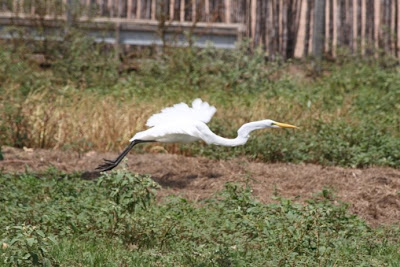But there were others who were involuntarily displaced from their homes by the storm — some that most people haven't even thought of as yet.

Last week as I was driving through some of the farmland near our home, 80-90 miles inland from the coast, I was surprised at the number of coastal and wetland birds I spotted. Several times I looked up at the sound of seagulls crying overhead, seemingly lost with the absence of sand and waves.
There were also many unusual scenes of egrets and ibises, wading through water still standing in fields that were flooded by the storm.

The majority of this group appeared to be cattle egrets (Bubulcus ibis — possibly immature, with yellow beaks and dark legs), which are common to the area; however, cattle egrets are not normally waders like the other egrets and herons found in this region, so I'm not positive I have identified them correctly.

Mixing in with these smaller egrets were at least three young roseate spoonbills (Ajaia ajaja), with their white plumage just starting to turn pink. This is the first time I have ever seen spoonbills this far inland or away from the coast or marshes.

A neighboring field hosted yet another pair of spoonbills, along with a half dozen or so of what I believe were snowy egrets (Leucophoyx thula — black bills, yellow around the eyes, black legs and yellow feet). They were fun to watch, appearing to dance as they walked through the watery grass, shaking a foot from time to time as they stepped gracefully forward.


In two fields I saw the much larger common egret (Casmerodius albus), towering over and yet standing apart from their much smaller cousins.

I spotted several dark forms mixed in with the fields of white waders, but at first couldn't tell what they were. Finally, just before I got back to town, I found a group much closer to the road and was able to spot the telltale downward curve of ibises.

The brown backs and wings, white undersides and mottled necks and heads mark these as immature ibises, although I can't say for certain whether these are white (Eudocimus albus) or scarlet (Eudocimus ruber) ibises.

White ibises are much more common along the Texas gulf coast, and I expect that is what these young birds were. However, I have heard of spottings of scarlet ibises in the coastal marshes near Sabine Lake, near the Texas-Louisiana border, or along the Bolivar Peninsula (just north of Galveston Island), so I suppose it is possible after a storm like Ike that those may have been blown a bit wayward.

In the days immediately following the hurricane's passage through the area, I found myself reading and re-reading Kenn Kaufman's column in the latest issue of Bird Watcher's Digest. He wrote of a recent visit to Galveston Island, and of the changes that have happened there over a number of years with regards to the human disruptions that have so affected bird habitats along the Texas coast. And with the limited space that has now been set aside for bird and wildlife habitation in this area, I wonder what sort of affect such a monstrous — if entirely natural — disruption such as Ike will prove to have on the birds of this region.







4 comments:
The Science Chimp is disappointed to find Kyle batting 100 on all his bird ID's. She will add that cattle egrets actually prefer upland meadow and pasture to wading in shallow--being insect eaters. Pretty sure you've got white ibis there--don't see much evidence of their being young scarlets, and that, even considering the hurricane, is very unlikely. Nice photos, nice ID's.
Eee! Eee! Eee!
Science Chimp, signing off.
Thanks for the photos. I have been stressing a little over the hurricane's aftermath. I love the shots of the pale pink spoonbills. They look like yummy strawberry ice cream. Good enough to eat.
These are fascinating accounts, photos and observations about these birds being displaced after the hurricane.
JULIE - Thanks for the check and confirmations. The cattle egrets really kind of threw me -- the more I thought about it, the more I doubted my ID of them. We see them all the time around here, but I've never seen them in and around water before.
BINS - I wish I could have captured one of the spoonbills in flight -- the undersides of their wings were almost flamingo-pink. Definitely a nice complement to all the white egrets they were hanging around.
ANN - Thanks for the kind words, and for dropping by!
Post a Comment